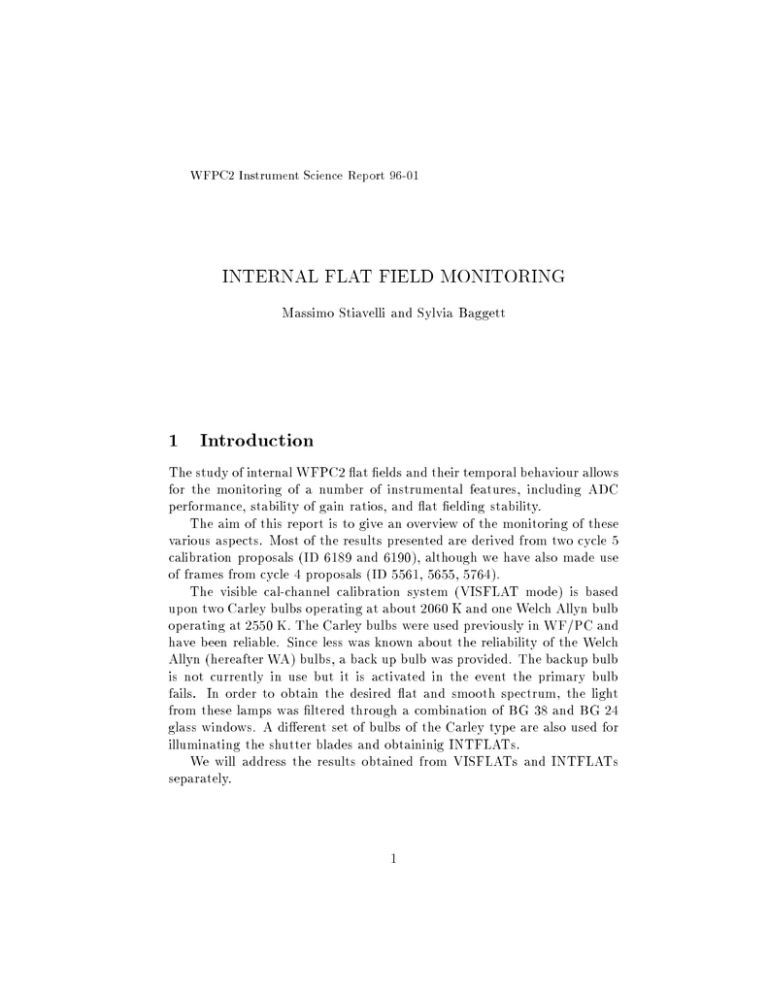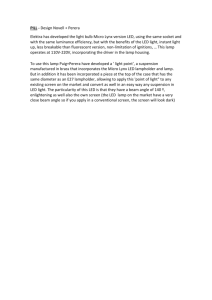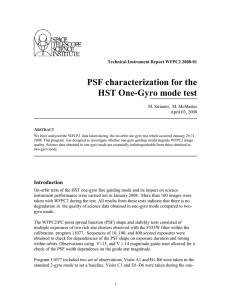Document 10379702
advertisement

WFPC2 Instrument Science Report 96-01 INTERNAL FLAT FIELD MONITORING Massimo Stiavelli and Sylvia Baggett 1 Introduction The study of internal WFPC2 at elds and their temporal behaviour allows for the monitoring of a number of instrumental features, including ADC performance, stability of gain ratios, and at elding stability. The aim of this report is to give an overview of the monitoring of these various aspects. Most of the results presented are derived from two cycle 5 calibration proposals (ID 6189 and 6190), although we have also made use of frames from cycle 4 proposals (ID 5561, 5655, 5764). The visible cal-channel calibration system (VISFLAT mode) is based upon two Carley bulbs operating at about 2060 K and one Welch Allyn bulb operating at 2550 K. The Carley bulbs were used previously in WF/PC and have been reliable. Since less was known about the reliability of the Welch Allyn (hereafter WA) bulbs, a back up bulb was provided. The backup bulb is not currently in use but it is activated in the event the primary bulb fails. In order to obtain the desired at and smooth spectrum, the light from these lamps was ltered through a combination of BG 38 and BG 24 glass windows. A dierent set of bulbs of the Carley type are also used for illuminating the shutter blades and obtaininig INTFLATs. We will address the results obtained from VISFLATs and INTFLATs separately. 1 2 VISFLATS Flat elds obtained with the visible cal-channel lamps have been inspected for all visible WFPC2 lters longward and including F300W. The relative count rates are given in Table 1. From the count rates we have derived a spectrum of the VISFLAT light by adopting the instrument eciencies listed in the WFPC2 Instrument Handbook (Figure 1). A very signicant pinhole in F300W has been identied just outside the eld of WF3 (see Figure 2). Although previously not reported and not listed in the thermal vacuum pinholes table (page 6-49 in TV Report), this pinhole was also visible in cycle 4 F300W visats and therefore has not developed recently. It is not visible in the pipeline F300W ats nor in the earth ats taken during cycle 5, probably due to the dierent optical paths between VISFLATs and external data. We conclude that the pinhole is unlikely to aect any science data. Additional pinholes are visible also in the same lter in WF2 and WF4 at the level of one percent or less, but they are much less prominent in the pipeline at elds and are also unlikely to aect science observations. We checked whether VISFLATs taken with short exposure time showed any systematic dierence in structure (after applying the shutter correction), but none has been seen to 0.5 % level. Therefore we conclude that the shutter corrections are consistent. Special attention has been devoted to the analysis of the wavelength dependence of the ratios between VISFLATS and the corresponding pipeline at elds which were obtained from a combination of ground based data and on orbit earth calibrations. If this ratio turned out to be independent of wavelength one would have had the option of an alternative strategy for producing at elds, by taking VISFLATS and correcting them with a purely geometrical term. In order to investigate this eect we rst \at elded" VISFLATS taken at dierent wavelengths by using the standard pipeline atelds and then computed their ratio. If the structures in the \at elded" VISFLATs are purely geometrical and wavelength independent this ratio should be spatially uniform. As shown in Figure 3 this is not the case. Dierences are present at all spatial scales from the whole chip down to diraction features. The typical size of these dierences is a few percent peak to peak for the whole frame and about 2 per cent in the innermost 400 by 400 pixels area. In order to verify whether these dierences were more geometrical in nature or dominated by a pixel to pixel variations, we have smoothed the at 2 Filter F300W F336W F380W F390N F410M F437N F439W F450W F467M F469N F487N F502N F547M F555W F569W F588N F606W F631N F656N F658N F675W F791W F814W F953N F1042M PC1 0.45 0.82 10.8 0.24 2.9 0.7 16.2 70.0 11.8 1.3 2.1 2.8 167 838.5 385.7 29.9 755.3 31.0 24 33.3 1074 864.3 1052 14.9 37.5 WF2 1.86 3.43 44.6 1.04 12 2.9 68.4 290.4 47.6 5.2 8.8 12 700 1739 1604 122.2 3136 125.1 99 134.3 4432 3575 4333 60.2 160.3 WF3 2.02 3.46 44.3 1.01 12 2.9 69.7 302.7 50.2 5.5 9.0 12 715 1800 1659 130.0 3229 129.0 101 137.4 4545 3715 4485 61.7 162.0 WF4 2.00 3.31 42.5 0.94 11 2.8 65.0 286.3 47.6 5.1 8.5 12 690 1727 1598 126.3 3124 127.9 96 135.9 4417 3646 4405 60.1 157.0 Table 1: Count rates (counts/s) in dierent lters for calibrated VISFLATs. 3 Figure 1: The VISFLAT light spectrum derived from the count rates in the individual lters corrected for the eciencies listed in the WFPC2 Instrument Handbook. 4 Figure 2: F300W VISFLAT on WF3. A pinhole aecting counts at more than 10 per cent level is visible in the top part of the frame. The pinhole center is outside the eld of view. 5 Figure 3: Ratio of the VISFLATS on WF3 in F555W and F814W after each has been atelded using the corresponding pipeline at. 6 eld ratios with a 3 by 3 pixel gaussian box. The variations remain essentially identical. Once the smoothed frame is subtracted from the original the residual frames appear dominated purely by noise. Therefore pixel-to-pixel variations seem to be properly corrected by the pipeline at elds. 3 FLAT FIELDING STABILITY The availability of VISFLATS taken regularly allows us to monitor both the at eld stability and the stability of the cal-channel lamp. The previously detected slow degradation of the cal-channel lamp is conrmed and its status continues to be monitored. In Figure 4 we show the ratio of mean uxes in VISFLATS taken about 1 year apart. Each measurement has been carried out on the innermost 400 400 pixels of a cosmic ray substracted mean of 6 VISFLATS, and is characterized by rather low noise. We observe signicant variations at F555W and F675W and smaller variations in the other lters. The ux variations that we detect are attributed mostly to a degradation of the cal-channel lamp since the photometric monitoring does not show any similar trend. Alternatively, one could monitor these variations by plotting the relative intensity as a function of time, number of exposures, number of lamp cycles, or number of hours of lamp \on" time. The clear result is that the degradation appears to be dependent on lamp usage. Although from an engineering point of view the number of lamp cycles should be the relevant quantity, our data do not denitively favour the correlation with number of lamp cycles over the one with total number of hours of usage. In Figure 5 we show the relative intensity as a function of lamp cycles. The cycles are counted as number of cycles since launch, however the systematic monitoring program only started after about 100 cycles. In addition, about 100 cycles were used during ground testing of the camera. The data for the dierent CCDs have been tted independently with a second order polynomial, but the resulting coecients are comparable for all chips. Although our data are not adequate to rmly establish the validity of the second order interpolation, the presence of an increase in slope with time is well established. The good agreement of the tted coecients for the 4 chips gives us enough condence to attempt an extrapolation of the ts. By extrapolating the available data we expect to cross 80 % eciency in about 200 more cycles and reach zero eciency in less than 1000 cycles, i.e. less than a factor 2.5 below the expected lifetime. Better data would be 7 Figure 4: Time degradation of the cal-channel lamp over a one year period for dierent lters. 8 required to improve our throughput estimates. The best interpretation to date is that the Welsh Allyn bulb is deteriorating and becoming dimmer and hotter; as a result, the ux is mostly lost at intermediate wavelengths (cfr Figure 4). More detailed models would be required to rmly identify the WA bulb as responsible for the overall decrease in throughput. To extend the lamp lifetime, VISFLAT usage will be reduced starting from February 1996. Despite the slow degradation of the lamp, we can determine how stable the at elds are spatially. A rst estimate is obtained by checking the mean uxes in the innermost 400 by 400 area on each chip. In Figure 6 we show, using dierent symbols for each chip, how the ratios have varied during 19941995 for the dierent lters. In order to correct for the lamp degradation eect, the uxes have been normalized to the ux in the chip WF3. All variations are signicantly smaller than 1 per cent, suggesting that WFPC2 at elds should be spatially very stable. More detailed studies were carried out for each chip by examining image ratios and measuring the amount of structure. In Figure 7 we show how the ratio of minimum to maximum mean count rates in areas of 50 by 50 pixels vary for the WF3 chip for the dierent lters. Similar results have been found for the other chips, thus conrming the geometrical stability of the WFPC2 at elds. 4 DECONTAMINATION VISFLATs have been taken regularly before and after each decontamination. The data allow tracking of the eciency variations due to contaminants and their removal by the decontamination. This eect is shown in Figure 8 where for various lters we show the ratio of counts before and after decontamination. The removal of contaminants appear to slightly increase the eciency in the UV and to slightly decrease it in the optical. Note however that the contaminants also introduce spatial dependencies in the at elding. The results of decontamination on the photometric accuracy will be addressed in a separate report. Here, we simply intend to note that contamination has eects smaller than 1 per cent on the mean at eld uxes. Since the photometric monitoring program shows a larger eect we conclude that contaminants are mostly causing a scattering of light to large angles, so that the photometry of point sources is more aected than the at elds. 9 1 1 0.98 0.98 0.96 0.96 0.94 F555W,PC1 100 200 0.94 300 100 Cumulative Lamp Cycles 200 300 Cumulative Lamp Cycles 1 1 0.98 0.98 0.96 0.96 0.94 F555W,WF4 F555W,WF2 100 200 0.94 F555W,WF3 100 300 Cumulative Lamp Cycles 200 300 Cumulative Lamp Cycles Figure 5: Relative intensity of the visual cal-channel lamp for the F555W lter as a function of the number of lamp cycles for the dierent CCDs. The relatively larger scatter observed for WF2 and WF3 is probably due to the presence of the most signicant contamination worms in these cameras. The solid lines are ts to the data. 10 Figure 6: Global spatial stability of the WFPC2 VISFLATs. We plot the ratios of the mean values of CRREJ combined images in the innermost 400 by 400 pixels. The lamp degradation has been subtracted by normalizing the uxes to the mean pre and post decontamination ux in WF3. 11 Figure 7: Time stability of at eld structures for the WF3 chip. We plot the ratio of minimum to maximum counts for six 1994 exposures divided by the same ratio for six 1995 exposures. 12 Figure 8: Ratio of the mean uxes within the central 400 by 400 pixels measured before and after decontamination for various lters. Contamination appears to decrease the UV eciency and increase the eciency in the optical. 13 5 COMPARISON OF VISFLATS, PIPELINE FLATS AND EARTH FLATS Our major concern was not the present of structures in the at eld ratios but their wavelength dependence. In fact, if the ratios of at elds turn out to be independent of wavelength, one can easily obtain one from the other with very high accuracy. In practice, we nd that the product of earth ats with pipeline ats (we use the product since the pipeline ats are actually inverse ats) and the product of VISFLATs and pipeline ats depend on wavelength. Consequently we have also checked whether the wavelength dependence is similar for VISFLATS and earth ats. This would indicate that VISFLATS could be used to produce improved at elds if securing earth ats became not feasible in the future. Since earth ats in optical broad band lters (F439W, F555W, F675W, F814W) saturate and an initial test of dark earth observations result in very low S/N images, we use as reference ats earth calibrations obtained with F336W,F390N, and F953N, and also the F606W and F814W sky at elds kindly provided by the Medium Deep Survey group. These lters were chosen so as to be at very dierent wavelengths from the better tested 5000 A region. Our earth ats were obtained by inspecting few tenths of recently acquired images and then coadding those without noticeable streaks and with the best S/N. Four to eight dierent frames were used for each at eld. We nd that the wavelength dependence of VISFLATs is dierent from the pipeline ats and the earth ats. The ratios of these dierent at elds vary both with position and wavelength. Earth-ats and VISFLATs are \at elded" by multiplying them by the pipeline (inverse) at. In the case of the MDS sky at since they have already been inverted we have dened the \at elded" sky at as the pipeline at divided by the sky at. In Figure 9 we show how the ratios of minimum to maximum counts in 40 by 40 pixel areas vary as a function of wavelength for the \at-elded" earth-ats and the \at-elded" VISFLATs. Most of these dierences are across the chip, while for the innermost 400 by 400 central pixels in each chip, variations tend to be smaller than 1 %. Once the whole chip area is considered, variations increase to 6.5 % peak to peak for the F336W and F814W VISFLATS and up to 16 % peak to peak for the F390N VISFLAT. Discrepancies are typically larger for the earthats. The comparison of F606W and F814W with the MDS sky at is instead quite good, with less than 2% and 3.6 % per cent 14 discrepancies peak to peak, respectively, for the WF chips and the PC. These tests suggest that VISFLATs will not allow us to improve at elding accuracy beyond that obtained by the latest delivery of pipeline ats. However, VISFLATs appear adequate to monitor a change in at eld structures and could probably be used to generate dierential at elds if any such changes were to be detected. 6 INTFLATs INTFLATS are calibration images taken with Carley-type bulbs and with the shutter closed. The light from the INTFLAT lamps is reected o the shutter and illuminates the CCDs. The dierent reectivities of the two shutters produce dierent INTFLAT patterns. The INTFLATs have been analyzed similarly to the VISFLATs. The major dierence between the two types of at elds is the very large spatial variability of INTFLATs. Monitoring of the INTFLAT throughput in F555W (which is the one most routinely monitored) did not show any indication of a decrease in intensity of the lamps, further indication that the decrease in VISFLAT throughput may be due to the WA lamp. If anything, we nd hints for an increase in (the Carley bulbs) intensity which is currently not understood. Since INTFLATs were taken with both shutter blades and both gain values, one can check the stability of these ratios. We have focussed on the time dependence of the ratio between dierent gains. As shown in Figure 10, the ratios of the two gains are constant with time to a high degree, guaranteeing that one can safely calibrate one gain and transfer the calibration to the other. We derive the following gain ratios for the 4 CCD chips: PC1 1.946, WF2 1.972, WF3 1.980, WF4 1.930. Holtzman et al. (1995) found, respectively, 1.987, 2.003, 2.006, and 1.955, so that the ratios of our gain ratios versus the Holtzman et al. values are: PC1 0.979, WF2 0.985, WF3 0.987, WF4 0.987. The absolute agreement is therefore better than 1.5 % for the WF chips and about 2 % for the PC which is also characterized by worst statistics. Since our ratios are aected by possible variations in lamp luminosity during the lamp cycles, one could allow for an overall correction. By doing so, all the WF chips gain ratios are in agreement with Holtzman's to within 0.1 %, while PC1 diers by 0.8 %. Since Holtzman et al. attribute a 1 % accuracy to their measurements, we consider the agreement between the two measurements to be very good. 15 Figure 9: Ratio of minimum to maximum ux for \at-elded" sky-earth at elds and VISFLATs. Dierent symbols are used for the individual chips. 16 1.05 1.05 F555W,PC1,A F555W,WF4,A 1 1 0.95 0.95 J.D. J.D. 1.05 1.05 F555W,WF2,A F555W,WF3,A 1 1 0.95 0.95 J.D. J.D. Figure 10: Ratio of whole chip intensities of INTFLATs taken with shutter A and gain 7 and 15. Results for shutter B are similar. The ratio appears to be stable and in agreement with the gain ratios determined by Holtzman et al. The gain 15 exposures are twice as long as the gain 7 ones. 17 7 SUMMARY Our results from a study of internal at eld images can be summarized as follows: 1. VISFLATs a new pinhole has been identied in F300W the ratios of VISFLATs to pipeline at elds are wavelength de- pendent at all scales an acceleration in the lamp degradation has been identied. The higher temperature Welch Allyn is identied as the most probable cause of the degradation at elds appear geometrically stable to better than 1 % contamination aects mean at eld intensities averaged over 400 400 pixels by less than 1 % 2. INTFLATs no throughput decrease with time is observed gain ratios appear stable to better than 0.1 % 8 Acknowledgement We thank Jesus Balleza for providing us with engineering data. 18






